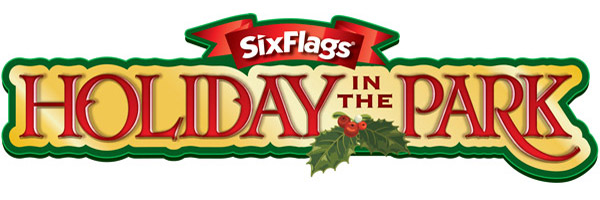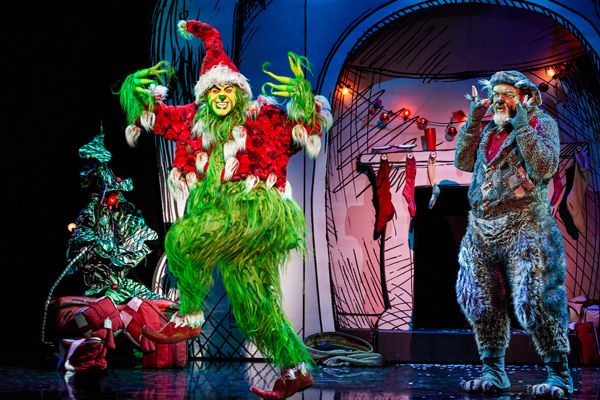By Ilene Dube, JerseyArts.com
originally published: 05/11/2023
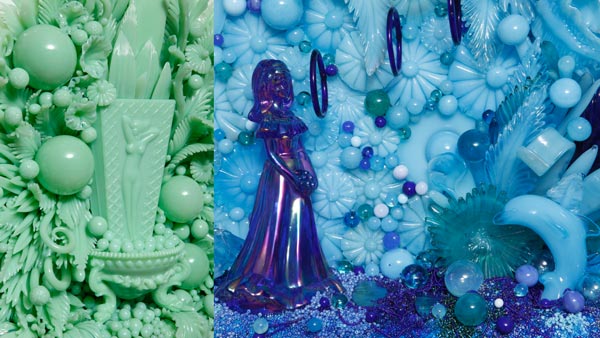
(LEFT) “Art Nude and Argonaut in Jade,” detail, 2023; (RIGHT) “Ecco to the Bridesmaid ‘I Know Not What Has Happened to Your Pod,’” detail, 2022. Works by Amber Cowan, photos by Matthew Hollerbush).
Ever since childhood, Amber Cowan has known she wanted to be a glass artist. Not just any artist – 2D, admittedly, is not her thing – but specifically, an artist who works in glass.
“I was always fascinated with the material and loved little glass animals,” she says from her studio in a commercial building in the Fishtown section of Philadelphia. “I just knew when I was 7 or 8 that it was what I wanted to do.” Even her first name – also the name of the fossilized tree resin prized for its luminescent beauty – hints at an attraction to translucent objects, although she acknowledges that her parents selected Amber for its popularity in the 1980s.
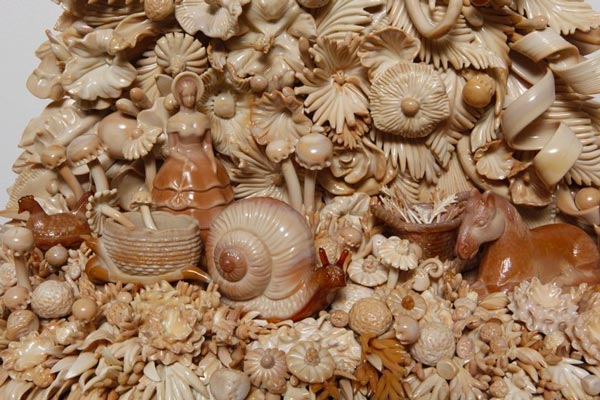
Amber Cowan, “Melanie Walking Snail with Cart,” detail, 2023 (Photo by Matthew Hollerbush)
“I have always loved work that was abundant, filled with stuff,” says Cowan, whose glass assemblages are on view in “Alchemy of Adornment” at the Museum of American Glass at WheatonArts through Dec. 31. As a child, “I loved ‘Where’s Waldo,’ packed with detail,” she says, referring to the British series of children's puzzle books in which the tiny eponymous character in the red-and-white striped shirt had to be ferreted out from enormous crowd scenes overflowing with minutiae.
Like cornucopias, Cowan’s glass compositions are replete with flora and fauna, fruit and figures, tangles of ocean life, and so much more. Each work tends to be in one color family, although some will build on contrasting colors.
And yes, some of these may remind you of your Aunt Sadie’s candy dishes or Grandma Gussie’s milk glass. Cowan's glass sculptures use recycled, upcycled and second-life American pressed glass – such as those aforementioned candy dishes. She employs the processes of flameworking, hot-sculpting and glassblowing to create large-scale sculptures that are ornate and have a quality she calls “viral accrual.”
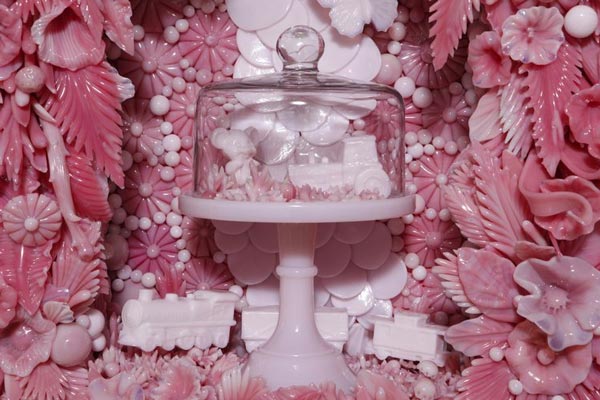
Amber Cowan, “Willie the Mouse with Tractor and Train,” detail, 2023 (Photo by Matthew Hollerbush)
“It refers to a kind of lushness that will keep growing and building,” Cowan says. Another term she uses is “horror vacui,” which is defined as a fear or dislike of leaving empty spaces in an artistic composition; the entire surface of the artwork is filled with detail and content.
The primary material used for her work is glass cullet sourced from scrap yards supplied by now-defunct pressed glass factories as well as flea markets, antique stores, and donations of antiques from households across the country.
“Nowadays, this material is out of fashion and relegated to the dustbin of American design,” she says on her website. “I take this material which is abundant on the shelves of thrift stores and flea markets and rejuvenate it into a new life.”
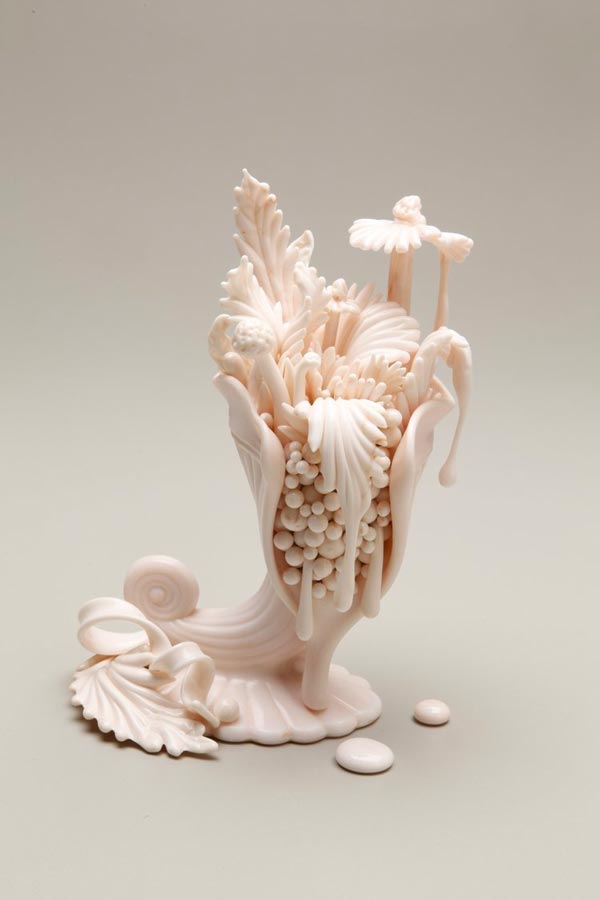
Amber Cowan, “Cornucopia in Shell,” 2021 (Photo by Matthew Hollerbush)
The discovery of this material and process came about while she was getting her MFA in Ceramics/Glass from Tyler School of Art and Architecture of Temple University in Philadelphia. “I found a barrel of old pink glass behind the furnaces of the studio. This barrel was filled with a run of broken pink Easter candy dishes with rabbits and chickens.” Once again, it was superfluity that attracted Cowan. “The material was abundant and beautifully colored in that initial barrel. Then it was down the rabbit hole of where the material came from and my fascination with the history and the colors produced by the factories.” What was initially a financial means to an end became a fascination with the history of the material.
“The color was beautiful and technically it melted very similarly to the soft glass I was trained to work with,” Cowan continues. “Soft glass is a more Venetian way of working.” Cowan has been to Murano, the Italian island just outside of Venice known for its glassmaking, to teach a workshop.
“This almost coincidental discovery transformed into a passion for history, industry and a new love affair with the material to which I was already in love,” says Cowan. She began researching the stories and formulations of the colors. “These barrels of color are often the last of their run and my work will essentially give the formulas their final resting place and visually abundant celebration of life.”
Those colors, with names such as “Bittersweet” orange, “Jadeite,” and “Rosalene,” once signified household taste and now form Cowan’s palette, according to exhibition materials.
“Alchemy of Adornment” juxtaposes Cowan’s creations with objects from the museum’s collection, building on the history of glass contained in Cowan’s work along with the rich history of glass in Millville, the center of the nation’s first glass industry. The availability of resources such as wood, sand, soda ash, silica, lime and wood, as well as proximity to water, attracted glassmakers to South Jersey beginning in the early 1700s. More than 200 glass factories once populated the region. WheatonArts grew out of glass manufacturer Wheaton Industries.
“Pressed glass was much less expensive than blown glass, making a touch of style affordable for the average household,” writes Director of Exhibitions and Collections Mary Mills in the exhibition labels. Molds were expensive to create, but from a business perspective, so was labor. The skills needed to operate a press could be learned within weeks or months compared to the years of apprenticeship required to become a skilled glassblower.
“By the end of the 20th century, these inexpensive wares, once proudly displayed in American middle and working class homes, had fallen from favor,” continues Mills in her description. “The change in fashion, along with competition from imported wares and other issues, gradually brought an end to the industry.”
Some of the molds, including one for “Art Nude,” remain in the WheatonArts collection. Cowan and the Glass Studio staff experimented with this mold and a few others, producing new work for the exhibition.
Cowan grew up in York, Pennsylvania, where her father was a loan officer at a bank and her mother was a math teacher. Her mother’s creativity was apparent in her affinity for cake decorating. An aunt who worked for Marvel comics also modeled creativity. And yes, Cowan’s grandparents did have candy dishes. “I have a photo of my dad in front of my great grandmother and her milk glass collection. It was an affordable collectible of a certain era, something you saw in a lot of households.”
Among the many artists who influenced Cowan are Paul Stankard, the acclaimed glass artist who makes his home in Mantua, New Jersey, where glass has been produced since 1739 – May 20, WheatonArts is honoring Stankard on the occasion of his 80th birthday.
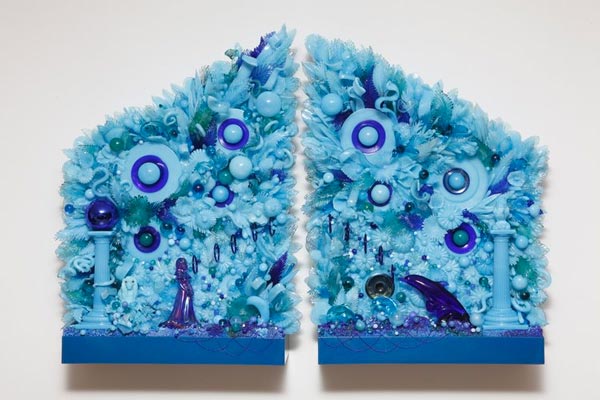
Amber Cowan, “Ecco to the Bridesmaid ‘I Know Not What Has Happened to Your Pod,’” detail, 2022 (Photo by Matthew Hollerbush)
Back in her studio, Cowan organizes the glass by color, sorting them on shelves. There are buckets of turquoise and blue cullet.
After being featured in The New York Times last fall, Cowan is frequently contacted by those wanting to donate glass. At press time she was planning a trip to Vermont to pick up an estate milk glass collection. “Sometimes people may have a broken piece they don’t want to throw out, but would like to see it given new life.”
Among the properties she seeks when collecting are colors that match the cullet she uses, as well as interesting textures and shapes. “Things that will animate the sculpture,” she says. “I look for special characters, animals, figurines. Things I can make a focal point, or pattern or texture.”
She likes to incorporate symbols of the feminine divine. “I don’t think you can look at my work and think a man-made it, it’s very feminine, incorporating feminine symbols.” The swan is a recurring character. “The swan was often made for candy dishes, typically with their necks toward each other as an exploration of love. The hen on a nest” was another motif.
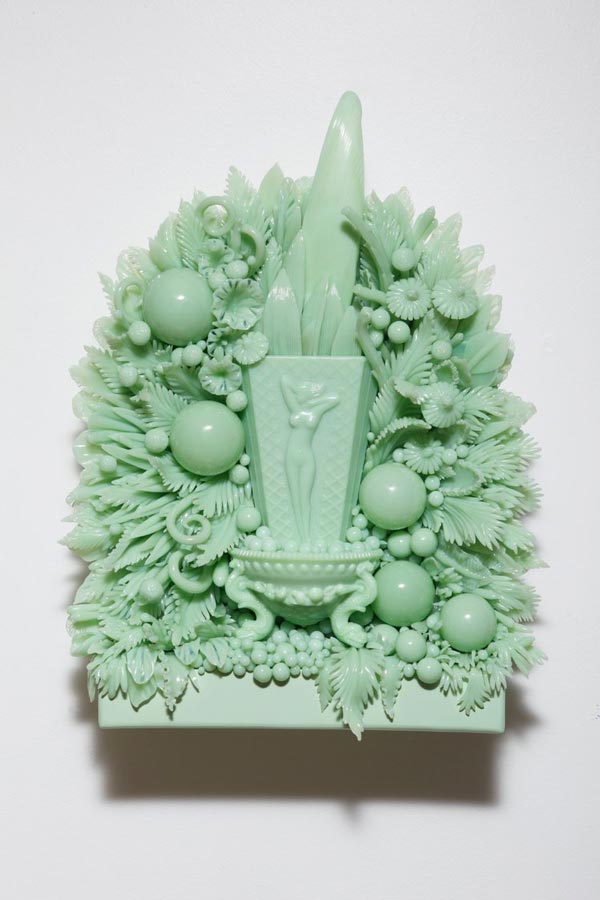
Amber Cowan, “Art Nude and Argonaut in Jade,” 2023 (Photo by Matthew Hollerbush)
When creating, Cowan is guided by the materials. “I think of scale and think about composition with elements that are found. It’s a back and forth between finding special elements and building the composition.” Cowan, who has taught at Tyler School of Art for 14 years, doesn’t color anything -- the color comes from the raw cullet. “Once I find a certain color I search for what I can use in that color.”
Trying to discern the found glass from what Cowan has created from the cullet is a quest that keeps her admirers on their toes. “Most of the floral elements, leaves, tendrils, and feathers I’ve created with flamework. Vases and figurines are generally the found glass. A misconception is that I take vases and melt them down. I melt the raw material in cullet form.”
About the author: Driven by her love of the arts, and how it can make us better human beings, Ilene Dube has written for JerseyArts, Hyperallergic, WHYY Philadelphia, Sculpture Magazine, Princeton Magazine, U.S. 1, Huffington Post, the Princeton Packet, and many others. She has produced short documentaries on the arts of central New Jersey, as well as segments for State of the Arts, and has curated exhibitions at the Trenton City Museum at Ellarslie and Morven Museum in Princeton, among others. Her own artwork has garnered awards in regional exhibitions and her short stories have appeared in dozens of literary journals. A life-long practitioner of plant-based eating, she can be found stocking up on fresh veggies at the West Windsor Farmers Market.
Content provided by
Discover Jersey Arts, a project of the ArtPride New Jersey Foundation and New Jersey State Council on the Arts.
FEATURED EVENTS
Narrow results by date, categories, or region of New Jersey.
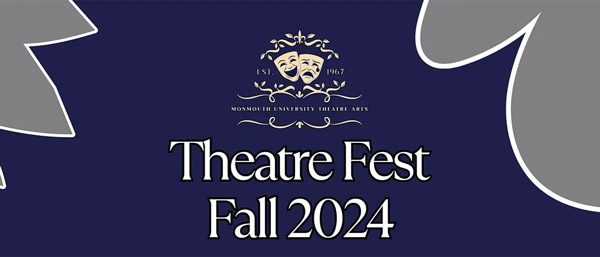
Theatre Fest Fall 2024 – Alpha Psi Omega Presents: To Be or Not to Be: Hamlet, an Abridged Staging
Saturday, November 23, 2024 @ 8:00pm
Monmouth University - Lauren K. Woods Theatre
370 Cedar Avenue, West Long Branch, NJ 07764
category: theatre
View event page for full information

Harry Potter and the Cursed Child (HS Edition)
Saturday, November 23, 2024 @ 7:00pm
Grunin Center
1 College Drive, Toms River, NJ 08754
category: theatre
View event page for full information

Harry Potter and the Cursed Child (HS Edition)
Saturday, November 23, 2024 @ 1:00pm
Grunin Center
1 College Drive, Toms River, NJ 08754
category: theatre
View event page for full information
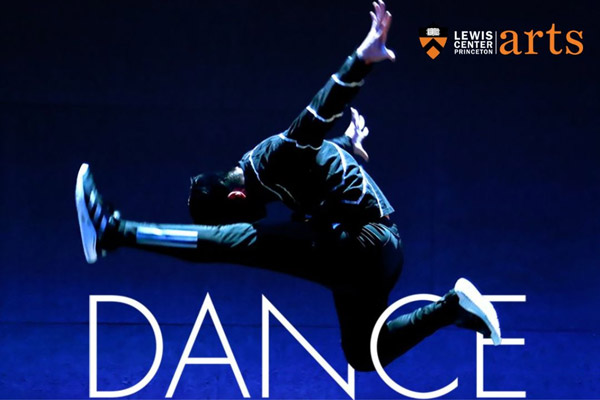
2024 Princeton Dance Festival
Saturday, November 23, 2024 @ 8:00pm
McCarter Theatre Center (Berlind Theatre)
91 University Place, Princeton, NJ 08540
category: dance
View event page for full information

2024 Princeton Dance Festival
Saturday, November 23, 2024 @ 2:00pm
McCarter Theatre Center (Berlind Theatre)
91 University Place, Princeton, NJ 08540
category: dance
View event page for full information
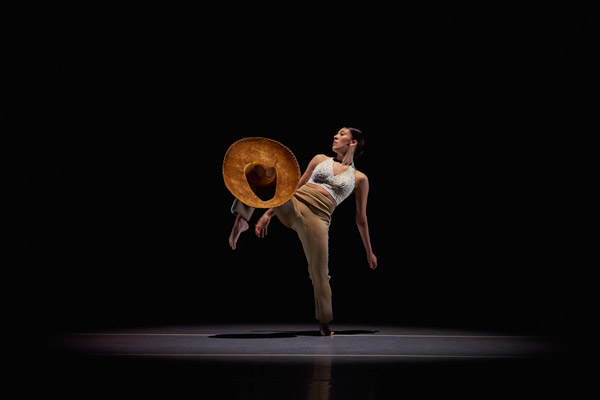
Fall Dance Plus
Saturday, November 23, 2024 @ 7:30pm
New Brunswick Performing Arts Center (NBPAC)
11 Livingston Avenue, New Brunswick, NJ 08901
category: dance
View event page for full information
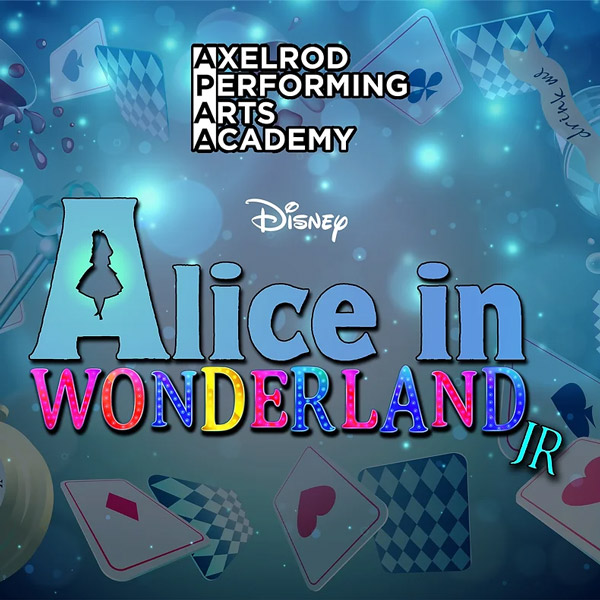
Axelrod Performing Arts Academy presents Disney's "Alice in Wonderland, Jr."
Saturday, November 23, 2024 @ 7:00pm
Bell Theater
101 Crawfords Corner Road, Holmdel, NJ 07733
category: theatre
View event page for full information

Axelrod Performing Arts Academy presents Disney's "Alice in Wonderland, Jr."
Saturday, November 23, 2024 @ 3:00pm
Bell Theater
101 Crawfords Corner Road, Holmdel, NJ 07733
category: theatre
View event page for full information
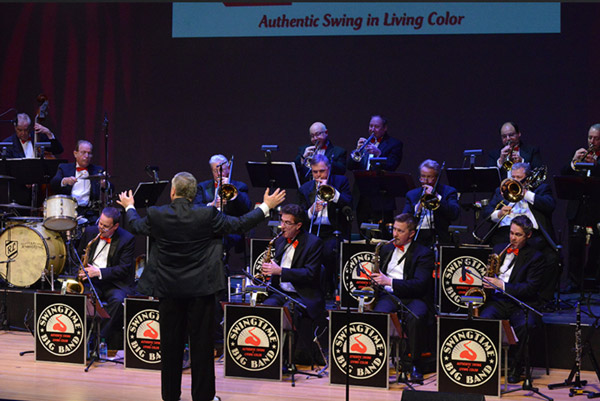
HAPPY FRANKS-GIVING! – Swingtime Big Band Celebrates Sinatra
Saturday, November 23, 2024 @ 8:00pm
Bergen Performing Arts Center (bergenPAC)
30 North Van Brunt Street, Englewood, NJ 07631
category: music
View event page for full information
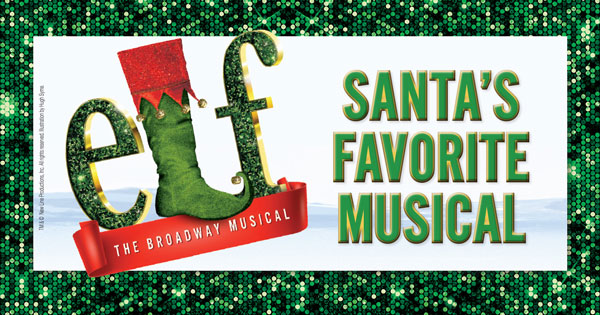
Elf The Musical
Saturday, November 23, 2024 @ 7:00pm
Count Basie Center for the Arts
99 Monmouth Street, Red Bank, NJ 07701
category: theatre
View event page for full information

Elf The Musical
Saturday, November 23, 2024 @ 1:00pm
Count Basie Center for the Arts
99 Monmouth Street, Red Bank, NJ 07701
category: theatre
View event page for full information
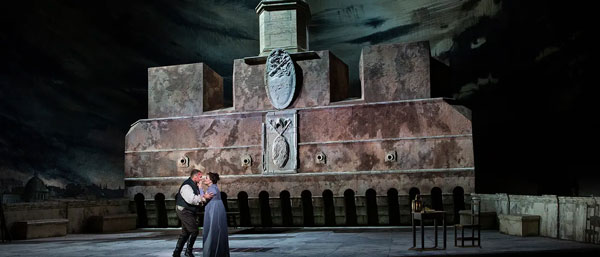
The Metropolitan Opera: Live in HD - Tosca
Saturday, November 23, 2024 @ 1:00pm
Monmouth University - Pollak Theatre
400 Cedar Avenue, West Long Branch, NJ 07764
category: theatre
View event page for full information
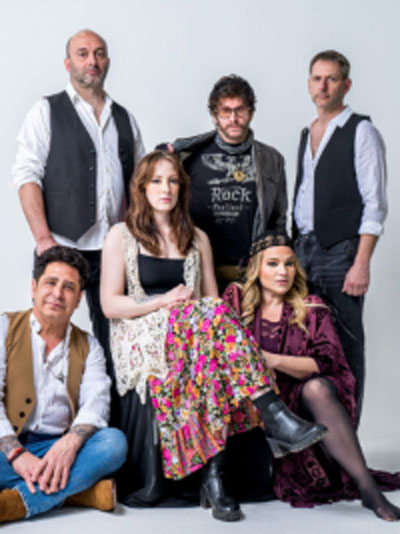
StevieMac: A Fleetwood Mac & Stevie Nicks Experience
Saturday, November 23, 2024 @ 8:00pm
William Paterson University - Shea Center for Performing Arts
300 Pompton Rd, Wayne, NJ 07470
category: music
View event page for full information
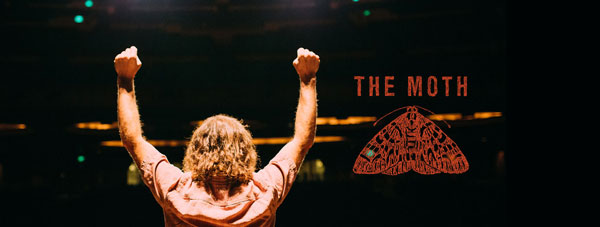
The Moth
Saturday, November 23, 2024 @ 7:30pm
McCarter Theatre Center (Matthews Theater)
91 University Place, Princeton, NJ 08540
category: community
View event page for full information

Dr. Seuss' How The Grinch Stole Christmas! The Musical
Saturday, November 23, 2024 @ 7:30pm
State Theatre New Jersey
15 Livingston Avenue, New Brunswick, NJ 08901
category: theatre
View event page for full information

Dr. Seuss' How The Grinch Stole Christmas! The Musical
Saturday, November 23, 2024 @ 3:00pm
State Theatre New Jersey
15 Livingston Avenue, New Brunswick, NJ 08901
category: theatre
View event page for full information

Dr. Seuss' How The Grinch Stole Christmas! The Musical
Saturday, November 23, 2024 @ 10:30am
State Theatre New Jersey
15 Livingston Avenue, New Brunswick, NJ 08901
category: theatre
View event page for full information
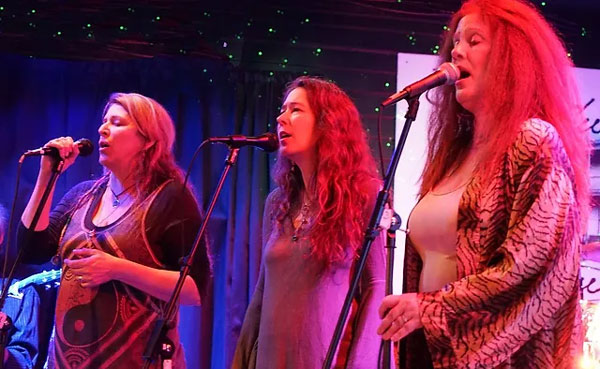
Wooden Ships Band
Saturday, November 23, 2024 @ 7:30pm
Lizzie Rose Music Room
217 E. Main Street, Tuckerton, NJ 08087
category: music
View event page for full information
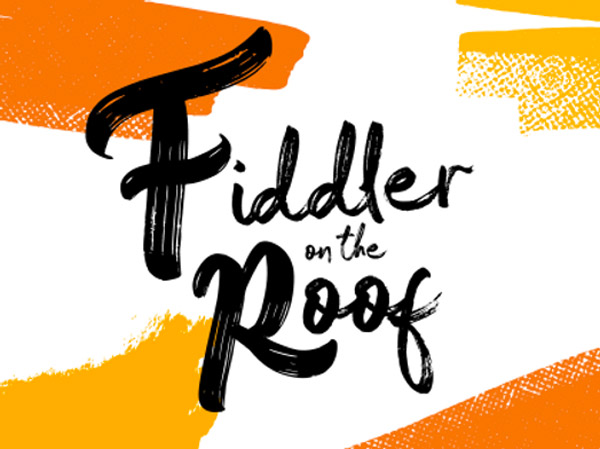
Fiddler On The Roof
Saturday, November 23, 2024 @ 7:30pm
Axelrod Performing Arts Center
100 Grant Avenue, Deal Park, NJ 07723
category: theatre
View event page for full information

Fiddler On The Roof
Saturday, November 23, 2024 @ 1:30pm
Axelrod Performing Arts Center
100 Grant Avenue, Deal Park, NJ 07723
category: theatre
View event page for full information
More events
Event Listings are available for $10 and included with our banner ad packages
EVENT PREVIEWS
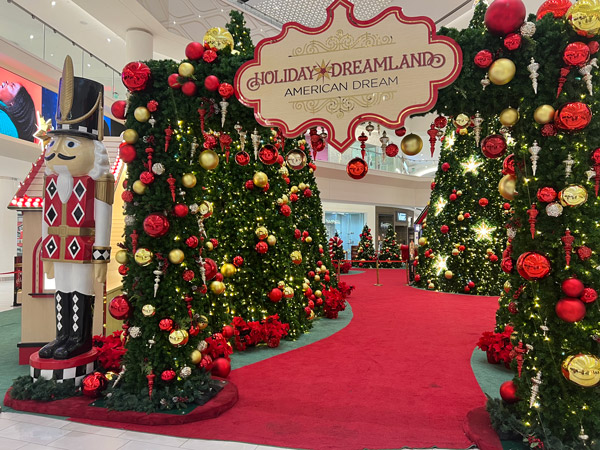
American Dream Announces Holiday Plans
(EAST RUTHERFORD, NJ) -- American Dream invites guests to spend the holidays at the one-of-a-kind center, as it transforms into a winter wonderland showcasing the very best in retail, dining and entertainment. Throughout the season, American Dream will be giving away incredible prizes, creating lasting memories and spreading joy throughout the community.
UPCOMING EVENTS
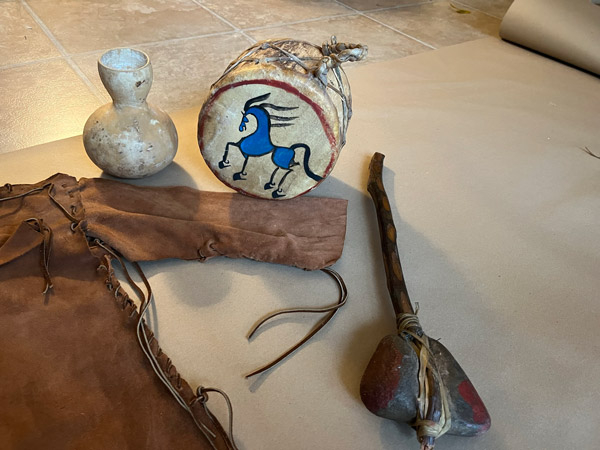
South Jersey's Indigenous Communities Celebrated in New A.C. Arts Garage Exhibit
(ATLANTIC CITY, NJ) -- A new exhibit at the Noyes Arts Garage of Stockton University will celebrate two southern New Jersey tribal communities through the display of historical documents, traditional artifacts and contemporary art. "Still Here: The Nanticoke Lenni-Lenape and Powhatan-Renape Nations of Southern New Jersey" opens October 9 and runs until January 5, 2025.























